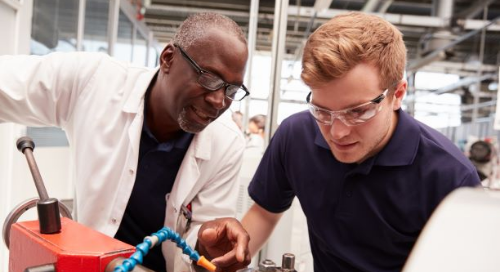When students have opportunities to learn emerging technologies in a hands-on environment, they bring those lessons into their professional careers — a win for students, educators and businesses.
Careers in 3D technology often begin with an interest in learning how things work, and then improving the process — the kids who took their toy apart to see what made them beep and then raced themselves to put it back together, who created an app or started a business — who played to win.
Likewise, colleges, universities and vocational learning centers are often the proving grounds for the next generation of adapters, innovators and inventors, for people who embrace both efficiency and creativity.
 At the University of North Carolina – Charlotte, the FARO ScanArm with Laser Line Probe has been an integral component of the University of North Carolina - Charlotte’s Motorsports Program. Situated within the William States Lee College of Engineering, the program develops student engineers for careers in auto racing, automotive, aerospace, design, manufacturing, and more.
At the University of North Carolina – Charlotte, the FARO ScanArm with Laser Line Probe has been an integral component of the University of North Carolina - Charlotte’s Motorsports Program. Situated within the William States Lee College of Engineering, the program develops student engineers for careers in auto racing, automotive, aerospace, design, manufacturing, and more.
Students can use the ScanArm in the classroom lab to reverse engineer car parts, to capture data to create parts, and as part of their workflow for building race cars. It’s been an invaluable tool for measuring the complex geometries that are common in suspension or engine parts.
According to Mason Marino, Research Operations Manager, “Reverse engineering and in-process quality assurance has been wildly improved,” and the students benefit from being exposed to laser scanning and 3D data capture hardware and software while they are still in school.
The biggest benefit has been exposing young engineers to a tool that is used in real life. Giving them that knowledge is a home run, and it gives them a competitive advantage.
Mason Marino, UNC - Charlotte Motorsports Program
Beyond the obvious educational benefits, the students enjoy the streamlined workflow and time savings. A job that would have previously taken 12 hours (that’s a lot of lab time!) can be accomplished in two hours. Scrap and rework time were reduced by up to 75%.
The result? For students, the time saved means more students have more opportunities to use the technology, to refine their skills and continue to iterate and create. And for educators, the value is in knowing each student engineer is prepared to carry the knowledge their alma mater gave them into the next phase of their lives.
FARO has a strong commitment to helping future 3D visionaries reach for excellence — if you’re interested in learning more about FARO’s educational pricing options, let’s talk. Call +1 (800) 736-023.
